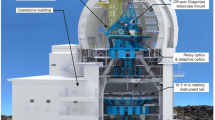Abstract
Ultraviolet spectrograms of a large number of faint stars up to 13m were obtained in the wavelengths 2000–5000 Å by means of the space observatory ‘Orion-2’ installed in the spaceship ‘Soyuz-13’ with two spacemen on board. The paper deals with a description of the operation modes of this observatory, the designs and basic schemes of the scientific and auxiliary device and the method of combining the work of the flight engineer and the automation system of the observatory itself.
It also treats of the combination of the particular parts of ‘Orion-2’ observatory on board the spaceship and the measures taken to provide for its normal functioning in terms of the space flight.
A detailed description is given of the optical, electric and mechanical schemes of the devices-meniscus telescope with an objective prism, stellar diffraction spectrographs, single-coordinate and two-coordinate stellar and solar transducers, control panel, control systems, etc. The paper also provides the functional scheme of astronavigation, six-wheel stabilization, the design of mounting (assembling) the stabilized platform carrying the telescopes and the drives used in it.
Problems relating to the observation program in orbit, the ballistic provision of initial data, and control of the operation of the observatory are also dealt with. In addition, the paper carries information of the photomaterials used, the methods of their energy calibration, standardization and the like. Matters of pre-start tests of apparatus, the preparation of the spacemen for conducting astronomical observations with the given devices, etc. are likewise dwelt on. The paper ends with a brief survey of the results obtained and the elaboration of the observed material.
Similar content being viewed by others
References
Gurzadyan, G. A., Kashin, A. L., Krmoyan, M. N., and Ohanesyan, J. B.: 1974, ‘Ultraviolet Spectrograms of Stars Obtained by “Orion-2”’,Astrofizika 10, 177.
Gurzadyan, G. A. and Ohanesyan, J. B.: 1975, ‘Spectrophotometry of Two “Ultraviolet” stars’,Astrofizika 11, No. 2.
Gurzadyan, G. A. and Ohanesyan, R. Kh.: 1975, ‘Ultraviolet Spectrophotometry of a Group of Hot Stars in Vela’,Astrofizika 11, No. 3.
Gurzadyan, G. A. and Rustambekova, S. S.: 1975, ‘Silicon Rich Stellar Envelope’,Nature 254, 311.
Gurzadyan, G. A.: 1975, ‘A Group of “Ultra-Violet” Stars in Auriga’,Observatory 94, 293.
Gurzadyan, G. A.: 1974, ‘Ultraviolet Spectra of Capella’,Nature 250, 204.
Gurzadyan, G. A.: 1975, ‘Ultraviolet Spectra of Planetary Nebula II 2149’,Monthly Notices Roy. Astron. Soc. 172, 249.
Gurzadyan, G. A.: 1974, ‘Ultraviolet Spectra of Faint Stars from Space’,Sky Telesc. 48, 213.
Gurzadyan, G. A.: 1974, ‘A Remarkable Ultraviolet Star Discovered by “Orion-2”’,Astrofizika 10, 379.
Gurzadyan, G. A.: 1975, ‘Ultraviolet Emission Lines in the Spectra of Cold Stars’,Monthly Notices Roy. Astron. Soc. 172, 617.
Gurzadyan, G. A.: 1975, ‘Behavior of 2800 Mg II in Stellar Spectra’,Publ. Astron. Soc. Pacific 87, 289.
Gurzadyan, G. A.: 1975, ‘Ultraviolet Spectrophotometry of Emission Star SAO 040183’,Astron. Astrophys. 39, 213.
Gurzadyan, G. A.: 1974, ‘On the Possibility of Spectral Classification of Stars by Their Ultraviolet Spectrograms’,Astron. Astrophys. 35, 493.
Gurzadyan, G. A.: 1975, ‘“Orion-2”: The First Scientific Results’,Space Sci. Rev. 23, 362.
Gurzadyan, G. A.: 1975, ‘Ultraviolet Spectra of Gamma Cassiopeia’,Astron. Astrophys. 40, 447.
Gurzadyan, G. A.: 1975, ‘Scientific Results of “Orion-2”’,Vestnik of Academy Sci., U.S.S.R. 13, No. 1.
Gurzadyan, G. A.: 1975, ‘Blending Effect of Ultraviolet Emission Lines in Hot Stars’,Astrofizika, in press.
Author information
Authors and Affiliations
Rights and permissions
About this article
Cite this article
Gurzadyan, G.A., Jarakyan, A.L., Krmoyan, M.N. et al. Space astrophysical observatory ‘Orion-2’. Astrophys Space Sci 40, 393–446 (1976). https://doi.org/10.1007/BF00640454
Received:
Issue Date:
DOI: https://doi.org/10.1007/BF00640454




